Learning Objectives
- Define life and identify the common features of life on earth that distinguish living organisms from non-living entities
- Explain biological evolution as an emergent property of life
- Know that organisms can be grouped by their evolutionary relatedness from domains (largest) to species (smallest), that every species on earth has a unique “scientific name,” and be able to recognize scientific names when you encounter them.
- Compare and contrast the defining characteristics of bacteria, archaea, and eukarya, the three domains of life. Contrast these to viruses.
- Explain the endosymbiotic theory of the origin of eukaryotes, and how endosymbiosis theory explains the unique characteristics of eukaryotes, relative to bacteria and archaea.
Life on Earth
We are intimately familiar with many of the living organisms around us because we’ve seen and interacted with “macroorganisms” all our lives. But some forms of life—”microorganisms”—went unrecognized for most of human history because they were impossible to see until microscopes were invented. Other living organisms may be difficult to recognize, even when seen, as in this picture below.

Lithops is a genus of succulent plants (like cacti) native to South African deserts. Lithops are often called ‘living stones’ because they look like surrounding rocks, excellent camouflage if you are a delicious desert plant. Can you spot them in the image above? Image from http://harrywoolner.wordpress.com/plants/lithops/
Defining “life” leads to questions: How do we distinguish life or non-life? What are the attributes that all living organisms on Earth share, and which of these attributes are exclusive to living organisms? What about the possibility of life on other planets with environments utterly unlike our planet? Mars may have once had life, and scientists hypothesize that Jupiter’s moon Europa has briny seas and hydrothermal vents beneath a layer of ice (Jaggard 2015). Suppose that we launched an exploratory mission to Mars or Europa, sending a laboratory module equipped with any type of analytical instrumentation you can think of. How would you search for evidence of life on Mars or Europa?
If we look at the fundamental properties of life, we can define some emergent properties:
- Need for energy
- Organization in membrane-bound cells
- Genetic information
- Ability to replicate
- Change (in a population) over time
NASA uses these properties to search for extraterrestrial life. NASA defines life as a self-sustaining chemical system capable of biological evolution.
Evolution as an emergent property of life
A key part of any definition of life is that living organisms reproduce. Let’s now add a couple of observations:
- Reproduction is a mostly accurate but imperfect process. When cells divide, they have to replicate their genetic material, called DNA, that encodes all the heritable traits of the organism. The unit of DNA is called a base, or nucleotide more formally. Although DNA replication is highly accurate, it still makes about 1 mistake in 10 million bases. For scale, human cells have ~3 billion bases. Over generations, a population will contain lots of heritable DNA variation.
- Reproduction causes a population of a given type of organism to grow exponentially, but the population size will reach a limit, where the individuals have to compete with each other for the limiting resource (food, space, mates, sunlight, etc.)
Suppose some heritable trait variants (speed, strength, sharper claws, bigger teeth) make some individuals more competitive for the limiting resource – what will happen?
The individuals with superior variants will acquire more resources, and have more progeny. If the superior variants are heritable, then their progeny will have the same superior traits. Over generations, a larger and larger proportion of the population will consist of individuals with the superior heritable variants. This process, called biological evolution, is change in the heritable characteristics of a population over succeeding generations.
Suppose there is heritable variation in a population, and the heritable variation makes a difference in the survival and reproduction of individual organisms. If these conditions exist, and they do for all natural populations of living organisms, evolution must occur. Therefore, by definition, life evolves!
Charles Darwin (1859) called this process natural selection. He and Alfred Wallace were the first to propose that evolution by natural selection could explain the origin of all the multitudes of species on Earth and how they appear so well-adapted in form and function to their particular environments. Moreover, Darwin proposed that all of life on Earth descended from a common ancestor via slow, incremental accumulation of heritable (genetic) changes. This big idea, that all life is related, turns out to be true: we all share the same genetic information, and the small changes accrued in DNA can be compared between species to reveal that every living organism sorts into one of three “domains” of life.
Three domains of life
The genetic information in all living organisms on earth is DNA. DNA sequence comparisons, as well as comparisons of structure and biochemistry, consistently categorize all living organisms into 3 primary domains: Bacteria, Archaea, and Eukarya. Both Bacteria and Archaea are prokaryotes, single-celled microorganisms with no nuclei, and Eukarya includes us and all other animals, plants, fungi, and single-celled protists – all organisms whose cells have nuclei to enclose their DNA apart from the rest of the cell. The fossil record indicates that the first living organisms were prokaryotes (Bacteria and Archaea), and eukaryotes arose a billion years later.
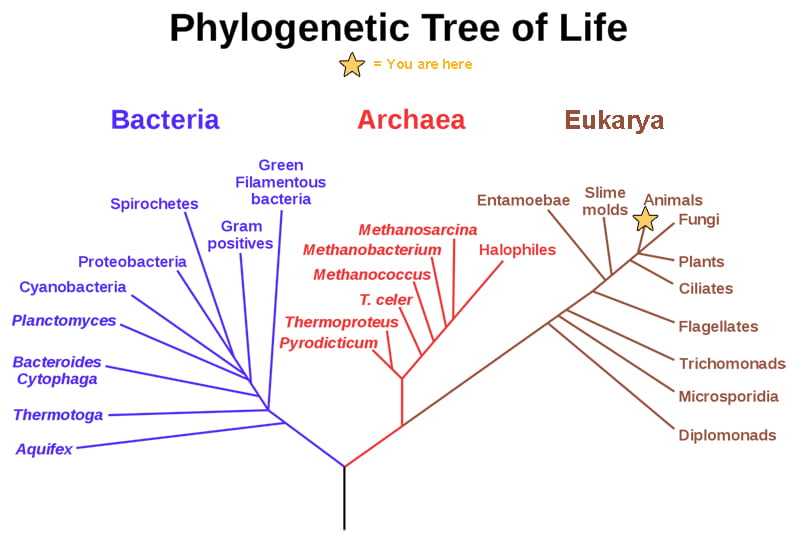
Humans are eukaryotes, but we are made up of cells from all three domains of life. Our bodies have about 37 trillion (3.7 x 10^13) human cells (hosts of the DNA inherited from our parents), and about 100 trillion (1 x 10^14) bacteria, mostly in the gut (American Society for Microbiology, Human Microbiome FAQ). We also have Archaea, primarily methanogens (responsible for flatulence!), though they appear to comprise less than 1% of our intestinal microflora (Lurie-Weinberger MN, Gophna U, 2015).
Previously, you may have learned that scientists classify organisms by the Linnaean System (Kingdom/Phylum/Class/Order/Family/Genus/Species), which is still true for Eukarya. The Linnaean system doesn’t work very well for bacteria and archaea, though. The “domain” level captures all three groups, and sits one level higher than Kingdom. Since the advent of DNA sequencing, we now understand that the higher classifications of that system do not always accurately reflect the genetic relatedness between those groups. Carl Linnaeus’ classification system stems from his work in the 1700s on how organisms look, long before we knew about DNA. The amazing thing to scientists now is how accurate the system is, given that it depends solely on morphological characteristics (physical form and structure).
What about Viruses?
Given their impact on living things, you are probably wondering where viruses fit into this organizational system. Are they alive? Viruses are not composed of cells and cannot reproduce on their own, but rather have to ‘take over’ a cell to replicate. Most biologists do not lose much sleep over the debate of whether viruses are classified as living. We think instead about how viruses operate in the world. Viruses act as obligate cellular parasites. That means that they can survive, reproduce, and create new variants when they live inside of and harm another organism.
How long can viruses survive outside a host? In a review of infections originating in hospitals, Kramer et al (2006) found that respiratory viruses, including influenza, corona, and rhino viruses, persisted on surfaces for up to several days. Gastrointestinal viruses often persist in humans for a couple of months, while blood-borne viruses like HIV can persist for more than one week outside a host.
We’ll look into the characteristics of viruses at several points this semester. For now, we can say that viruses use either DNA or RNA for their hereditary material. They also require a host cell to carry out their metabolic activities.
How do we organize all these organisms?
Sweden’s Carl Linnaeus published Systema Naturae (1735), which established the organizational system that we still use to name and classify life on earth. Linnaean classification gives us the ability to give a unique, two-word scientific or Latin name to each species. Ours is Homo sapiens, with the full classification of:
- Domain: Eukaryota
- Kingdom: Animalia
- Phylum: Chordata
- Class: Mammalia
- Family: Hominidae
- Genus: Homo
- Species: Homo sapiens
Humans are the only remaining member of their genus today, but other members of the family Hominidae include orangutan, gorilla, chimpanzee, and bonobo. Linnaeus didn’t have access to the evolutionary thinking that Darwin and Wallace published over 120 years later, but his organizational categories of species, genus, family, order, class, and phylum often align with the evolutionary relationships we find in the tree of life. (His top level of Kingdom isn’t considered evolutionary robust, so most biologists use domain now instead.)
Wrap up by viewing the Crash Course take on taxonomy, the classification system for all life on Earth:
Traits of the three Domains of Biological Diversity [adapted from OpenStax Biology]
As Linnaeus did, we still classify organisms according to particular traits they have in common. At the domain level, we can consider representatives of each of the domains to help us define the characteristics of eukarya, archaea, and bacteria.
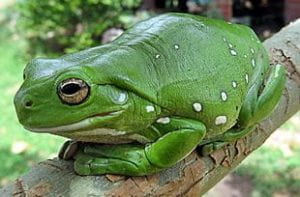
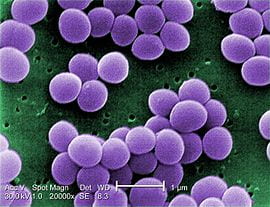
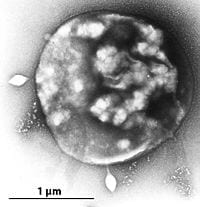
Figure: Eukarya (represented by the Australian green tree frog, left), Bacteria (represented by Staphylococcus aureus, middle) and Archaea (represented by Sulfolobus, right). [Photo credits: LiquidGhoul, Janice Haney Carr (CDC), Xiaoyu Xiang, in the Public Domain on Wikimedia Commons.]
Bacteria and archaea, together called prokaryotes, are abundant and ubiquitous; that is, they are present everywhere. Prokaryotes are single-celled, and were the first inhabitants on Earth, appearing 3.5 to 3.8 billion years ago. In addition to living in moderate environments like the digestive systems of mammals, they are found in extreme conditions: from boiling springs to permanently frozen environments in Antarctica; from salty environments like the Dead Sea to environments under tremendous pressure, such as the depths of Challenger Deep; and from areas without oxygen, such as a waste management plant, to radioactively contaminated regions, such as Chernobyl.
Bacteria and Archaea [adapted from OpenStax Biology]
Bacteria and Archaea are structurally similar. They have a plasma membrane that houses the cell’s internal content in a single compartment filled with cytoplasm, ribosomes, and DNA. Their DNA is not separated from the rest of the cell by a membrane. Most prokaryotes have cell walls made of peptidoglycan, and many have polysaccharide capsules. Their cells are small, ranging in diameter from 0.1 to 5.0 μm (micrometer, or 1/1,000,000th of a meter, or very small).
Here’s why cell size matters: As a cell increases in size, its surface area-to-volume ratio decreases. If the cell grows too large, the surface area becomes too low relative to the increased volume and essential elements cannot diffuse through the cell’s membrane. So, single-celled organisms have a size limit that is set by the diffusion rate across the cell’s membrane surface area.
While they have many similarities, here are three key differences between Bacteria and Archaea that you should know:
1) Bacteria cell walls contains peptidoglycan while Archaea cell walls do not. Archaea cell membranes have a different biochemical structure than either bacteria or eukarya.
2) Bacteria have a simple RNA polymerase enzyme, while Archaea have a complex RNA polymerase enzyme, similar to Eukarya. RNA polymerase builds strands of RNA, an important biological molecule that is a middle step in the path between the genetic information of DNA and the action molecules of proteins in a cell. We’ll learn more details about this later in the course.
3) When RNA is translated into proteins in archaea and eukarya, the first amino acid is called methionine (Met), but bacteria use a slightly different version of this amino acid, called formylmethionine (f-Met).
The following two videos explain in lecture format the characteristics that define bacteria (just watch from time index 0:00 to 3:46).
and the characteristics that define archaea (just watch from time index 0:00 to 3:19).
Eukaryotes and Eukaryotic Origins [adapted from OpenStax Biology]
The earliest fossils found appear to be Bacteria, most likely cyanobacteria. They are about 3.5 billion years old and are recognizable because of their relatively complex structure and, for prokaryotes, relatively large cells. Most other prokaryotes have small cells, 1 or 2 µm in size, and would be difficult to pick out as fossils. Most living eukaryotes have cells measuring 10 µm or greater. Structures this size, which might be fossils, appear in the geological record about 2.1 billion years ago.
Characteristics of Eukaryotes
Data from these fossils have led comparative biologists to the conclusion that all living eukaryotes are all descendants of a single common ancestor. Mapping the characteristics found in all major groups of eukaryotes reveals that the following characteristics must have been present in the most recent common ancestor of the eukaryotes because these characteristics are present in at least some of the members of each major lineage.
- Cells with nuclei surrounded by a nuclear envelope with nuclear pores. This is the single characteristic that is both necessary and sufficient to define an organism as a eukaryote. All extant eukaryotes have cells with nuclei.
- Mitochondria. All eukaryotic lineages have mitochondria, though in a few species they are reduced to remnants of mitochondria.
- A cytoskeleton. All extant eukaryotes have the cytoskeletal elements called actin microfilaments and microtubules.
- Flagella and cilia, organelles associated with cell motility. Some extant eukaryotes lack flagella and/or cilia, but they are descended from ancestors that possessed them.
- Chromosomes, each consisting of a linear DNA molecule coiled around basic (alkaline) proteins called histones. The few eukaryotes with chromosomes lacking histones clearly evolved from ancestors that had them.
- Mitosis, a process of nuclear division wherein replicated chromosomes are divided and separated using elements of the cytoskeleton. Mitosis is universally present in eukaryotes.
- Sex, a process of genetic recombination unique to eukaryotes in which diploid cells undergo meiosis to yield haploid cells called gametes. Gametes fuse together to create a diploid zygote nucleus.
Endosymbiosis and the Evolution of Eukaryotes [Adopted from Openstax Biology]
All living eukaryotes now are descendants of an organism that was a composite of a host cell and an oxygen-using bacterial cell that “took up residence” inside the host cell. This process of one cell engulfing another, where the engulfed cell survives and both cells benefit is called endosymbiosis. Endosymbiosis explains the fundamental characteristics of eukaryotes. Evidence for this includes cell membrane structure similar to bacteria and separate genomes inside mitochondria and chloroplasts that show closer relatedness to bacteria than archaea or eukarya. Endosymbiotic events likely contributed to the origin of the most recent common ancestor of today’s eukaryotes and to later diversification in certain lineages of eukaryotes.
The diagram below explains, in three steps, the theory of how eukaryotes evolved. First, the ancestral eukaryote evolved some internal organization in the form of organelles, including a nucleus to sequester the DNA. Second, this ancestral eukaryote engulfed an energy-producing bacterium that evolved into the modern mitochondria that all eukaryotes possess. Third, one lineage of eukaryotes acquired a second endosymbiont that evolved into the chloroplasts of modern photosynthesizers like plants and green algae. The chloroplast is the organelle that allows plants and others to harvest their energy from sunlight.
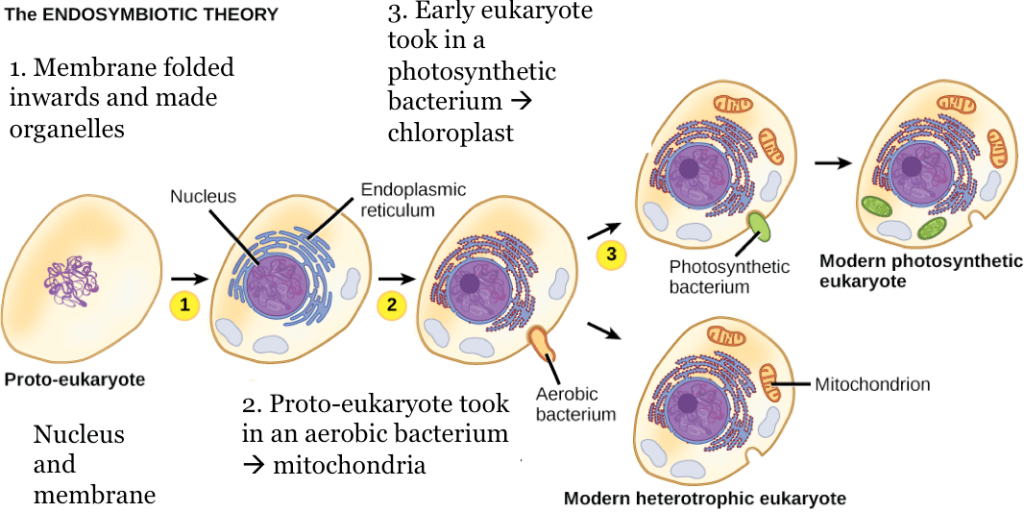
Image Credit: Open Stax Biology, modified by Chrissy Spencer.
Wrap-up
Review these ideas by adding your own characteristics to the table below to summarize the similarities and differences in bacteria, archaea, and eukarya:
| Characteristic | Bacteria | Archaea | Eukarya |
| Cell number | Single-celled | Single-celled | Multicellular, mostly |
| Cell walls contain peptidoglycan | Yes | No, contain chitin | No, contents vary |
| Flagella | Spin | Spin | Undulate |
| RNA polymerase | Simple | Complex | Complex |
| DNA enclosed by a membrane | No | No | Yes |
| Chromosome | Circular (usually) | Circular | Linear |
| Protein translation initiated with amino acid | f-Met | Met | Met |
| Membrane-enclosed organelles | No | No | Yes |
References
Darwin, C. 1859. On the Origin of Species by Means of Natural Selection. London: John Murray, Albemarle Street.
Kramer, A., Schwebke, I. & Kampf, G. 2006. How long do nosocomial pathogens persist on inanimate surfaces? A systematic review. BMC Infect Dis 6, 130. https://doi.org/10.1186/1471-2334-6-130.
Lurie-Weinberger MN, Gophna U (2015) Archaea in and on the Human Body: Health Implications and Future Directions. PLoS Pathog 11(6): e1004833. https://doi.org/10.1371/journal.ppat.1004833
